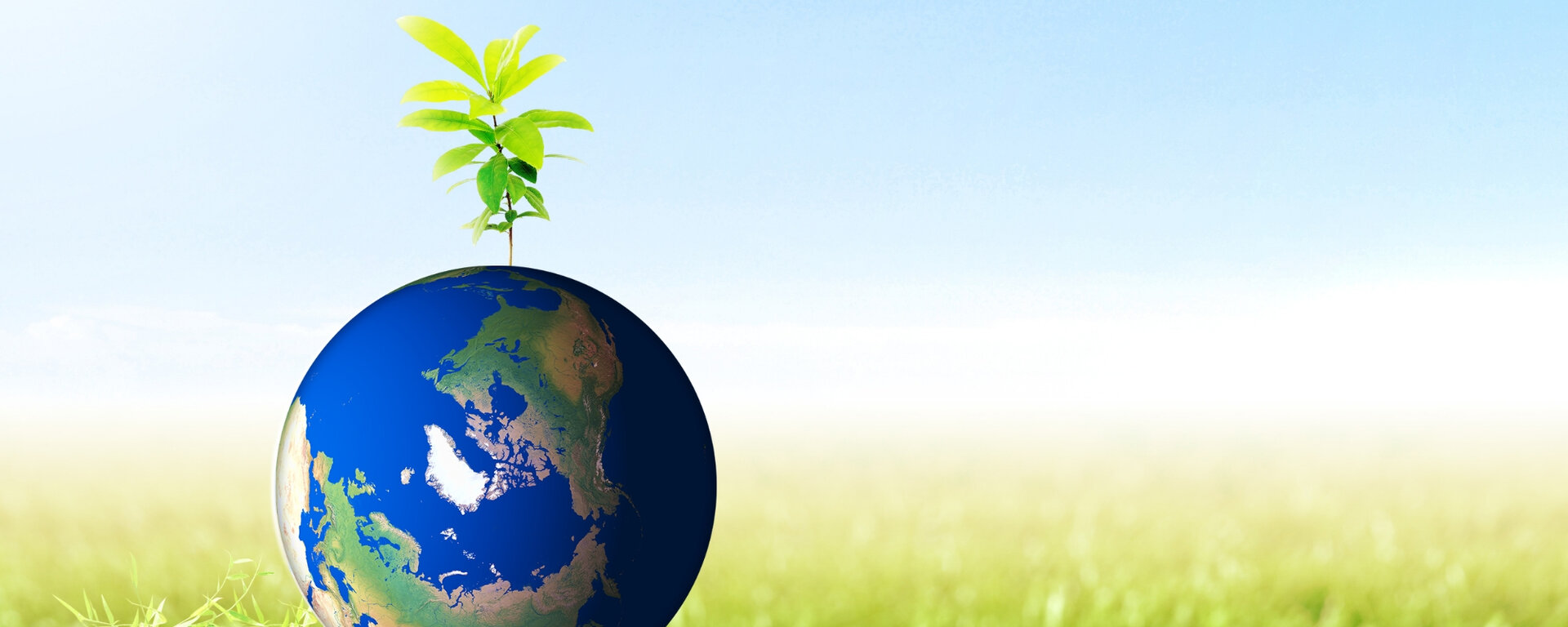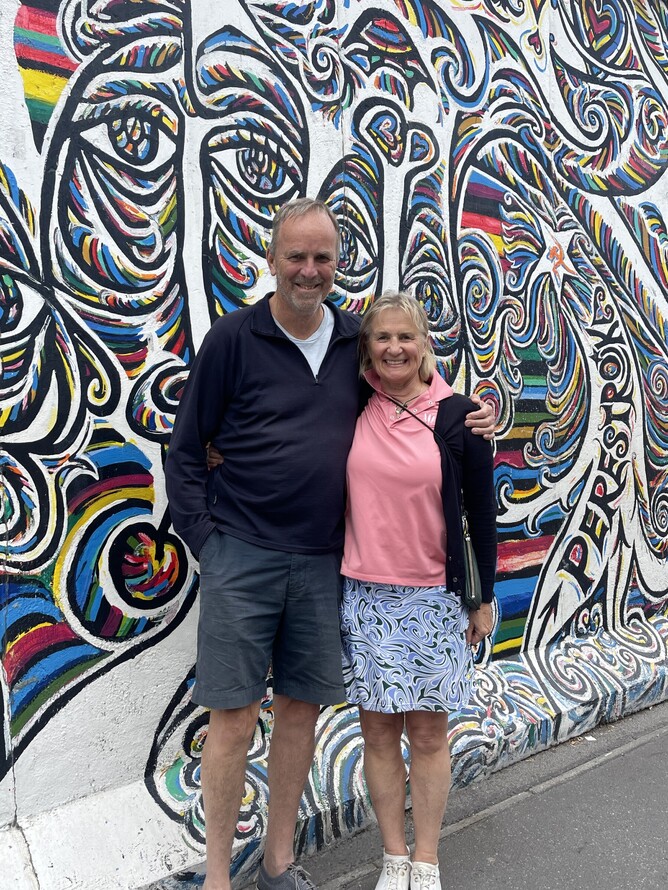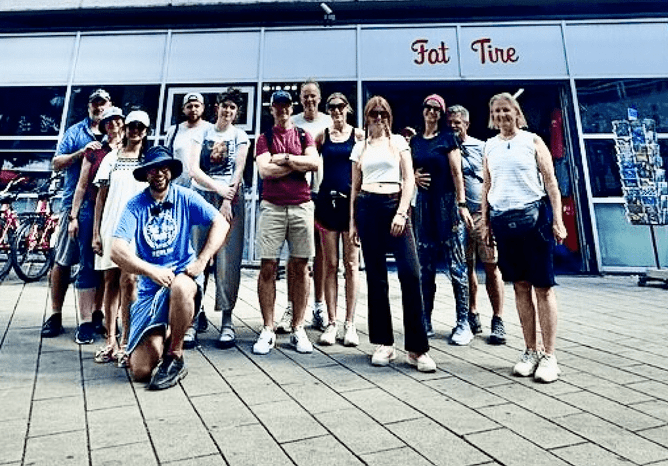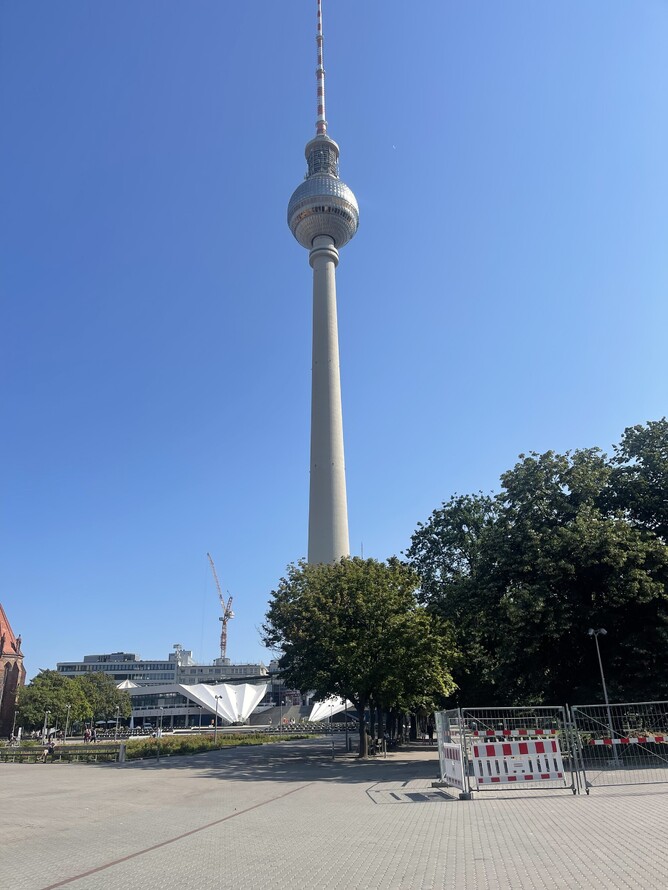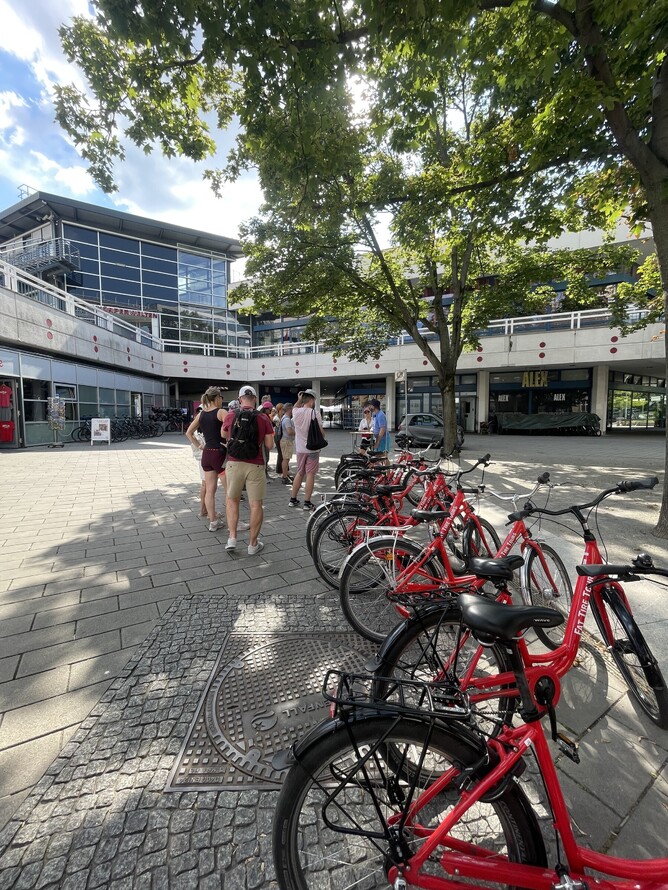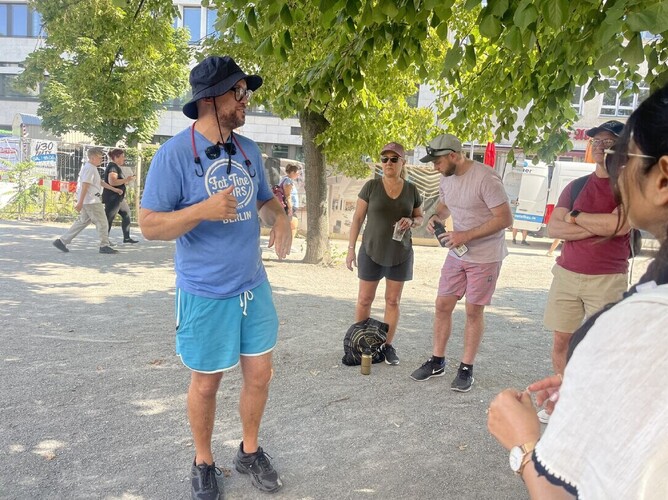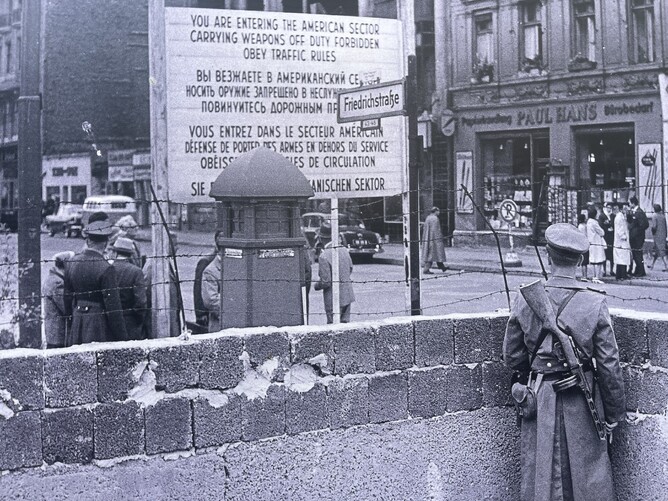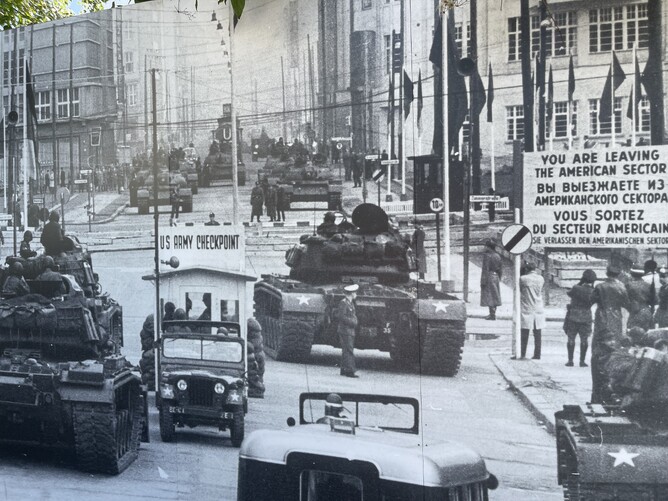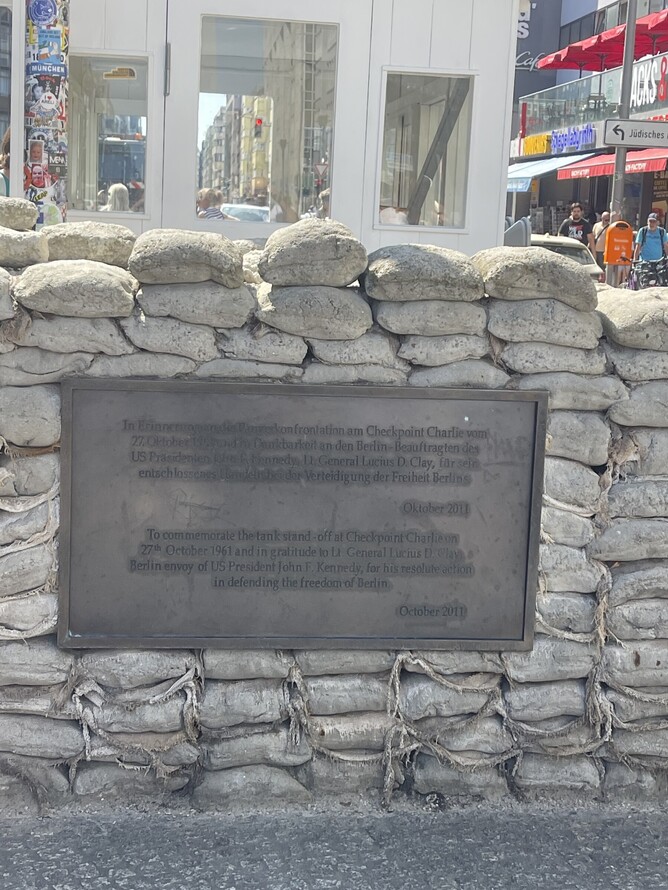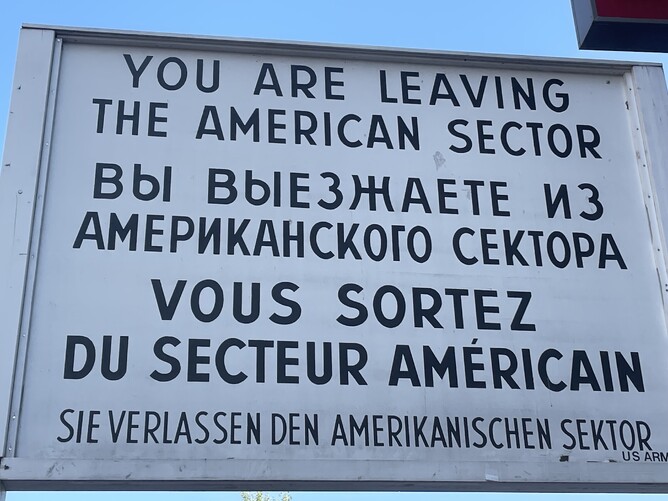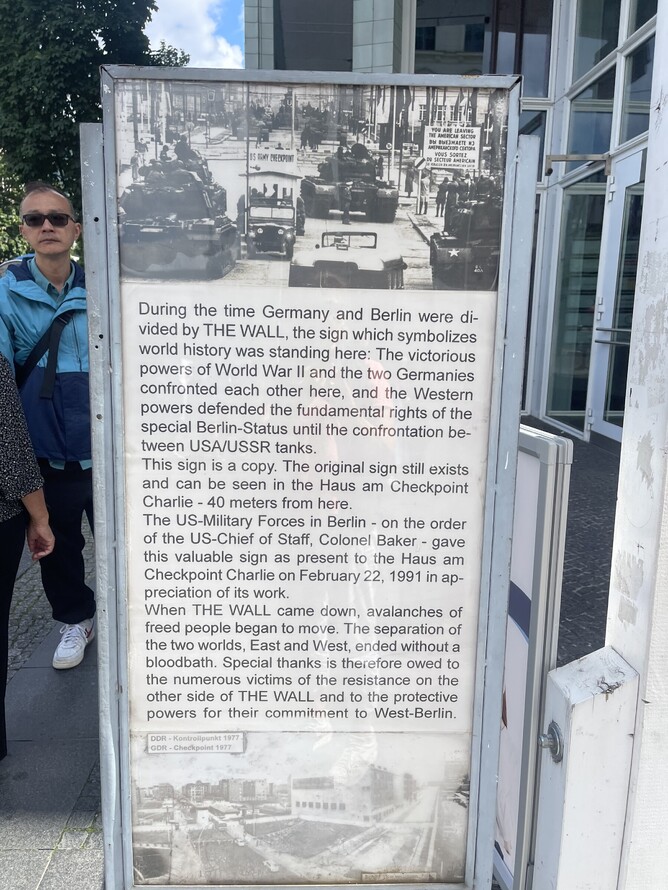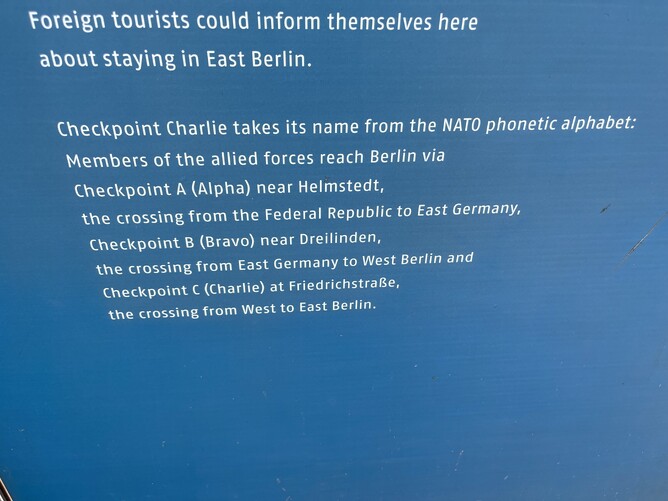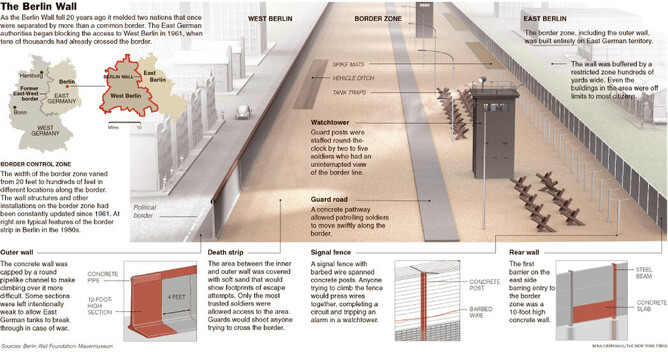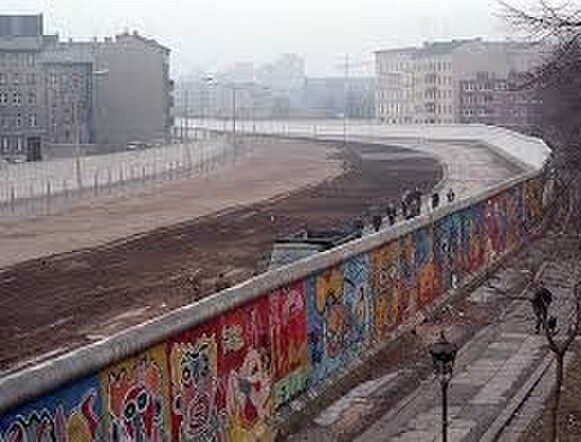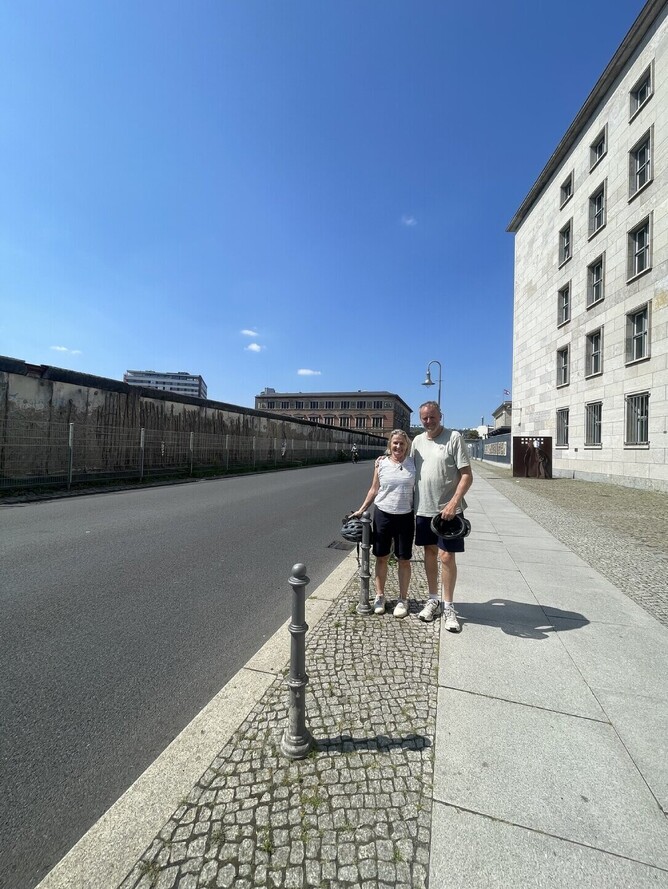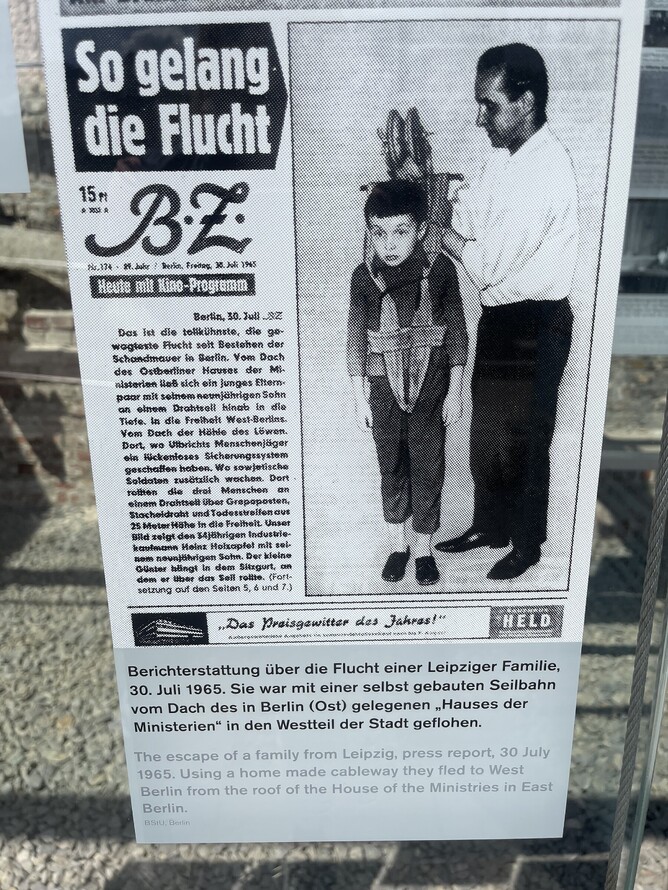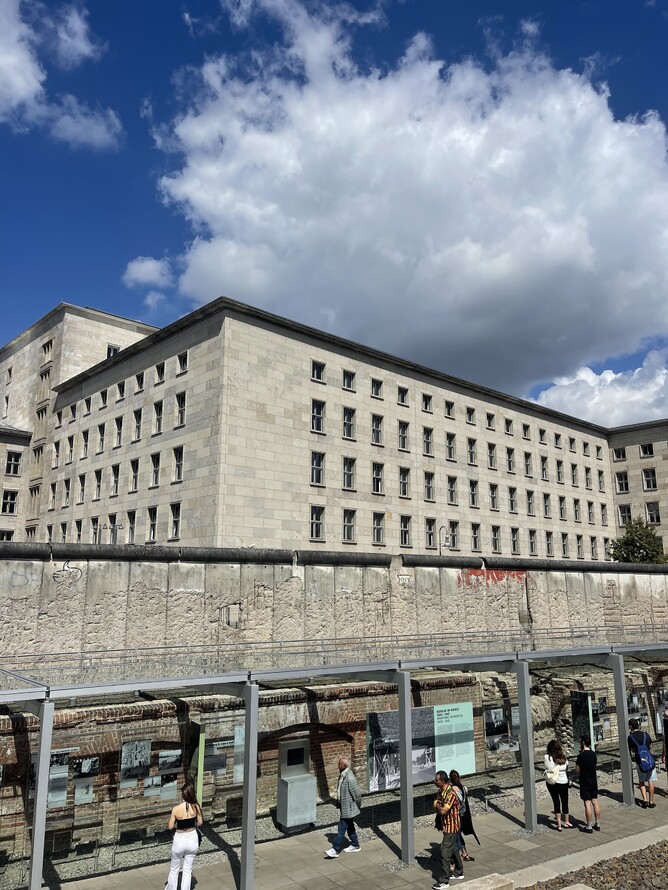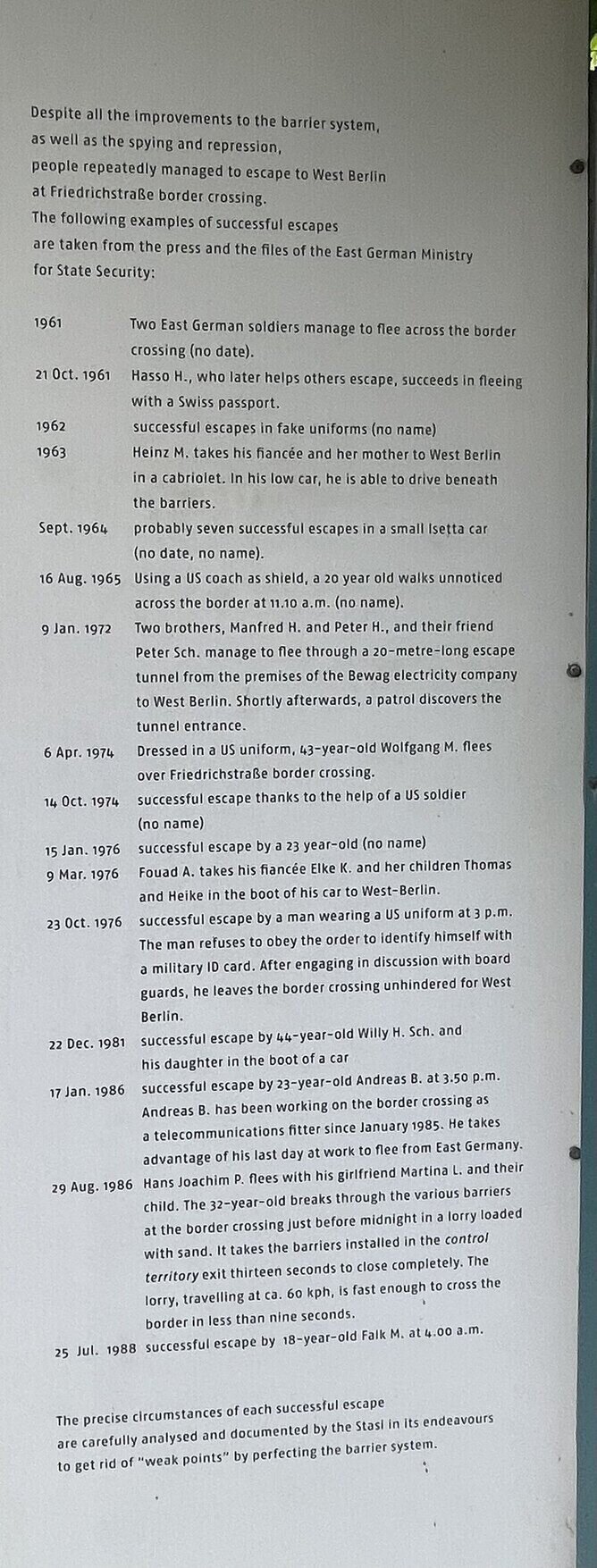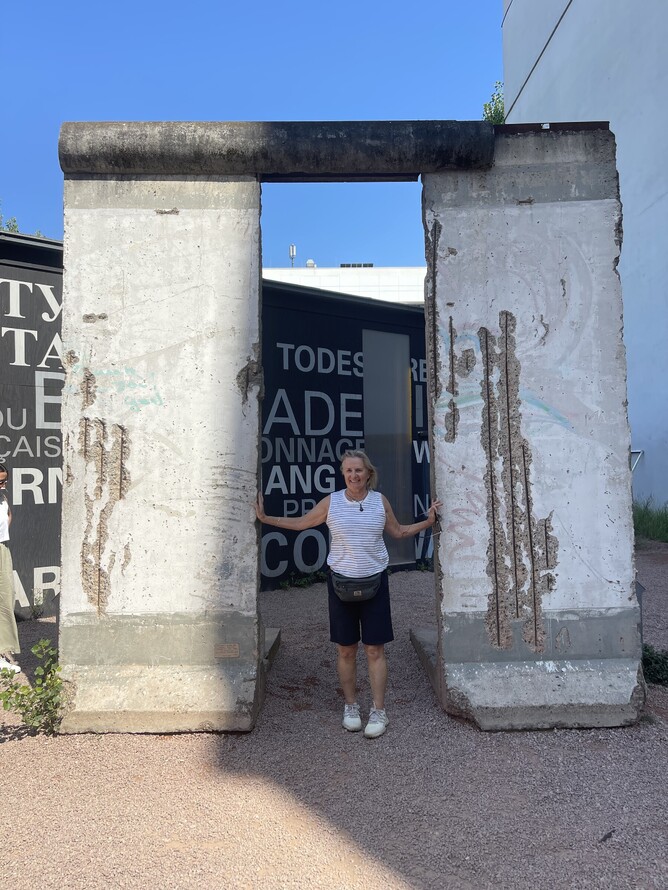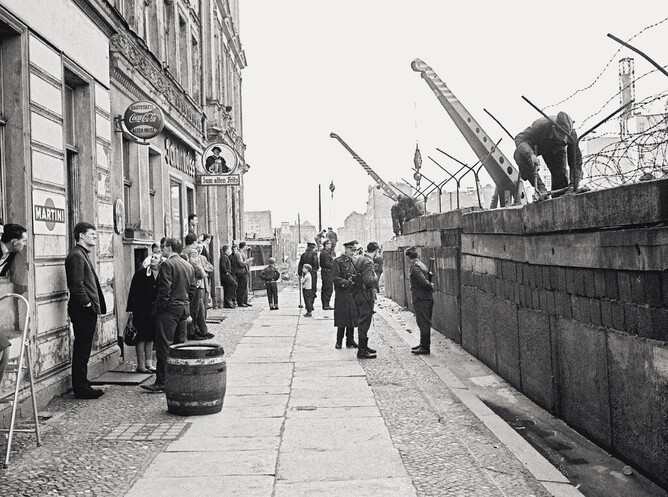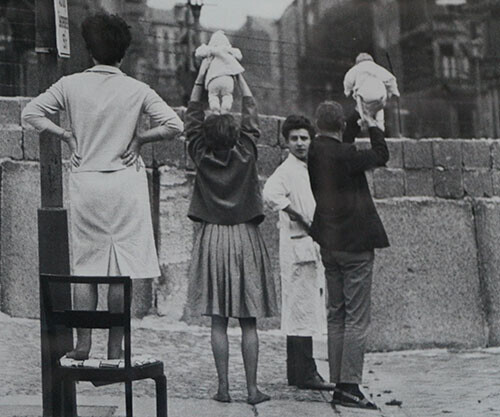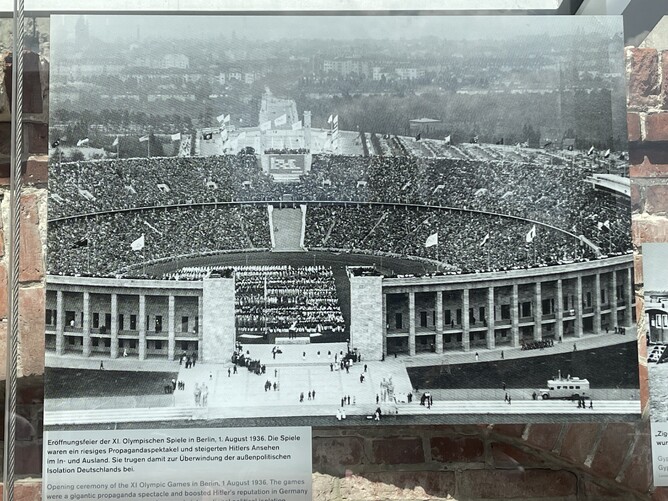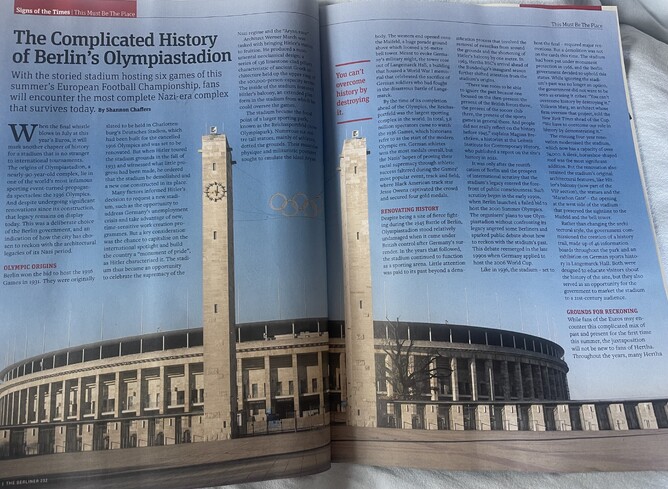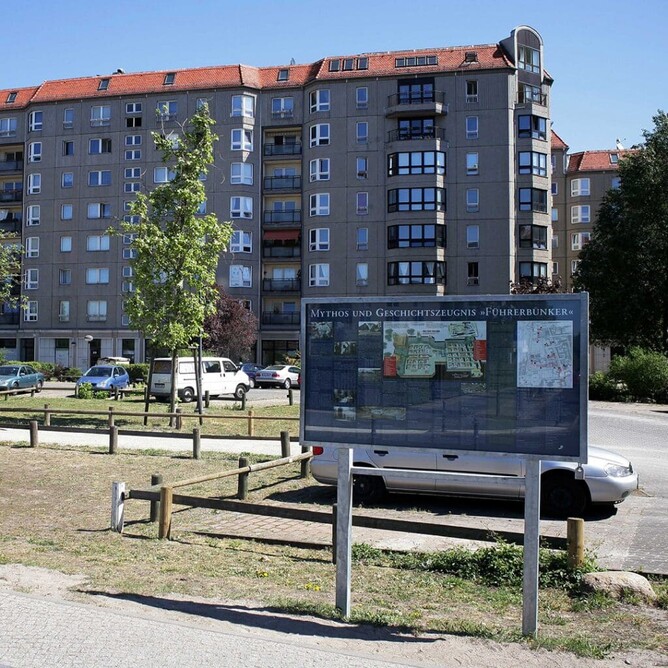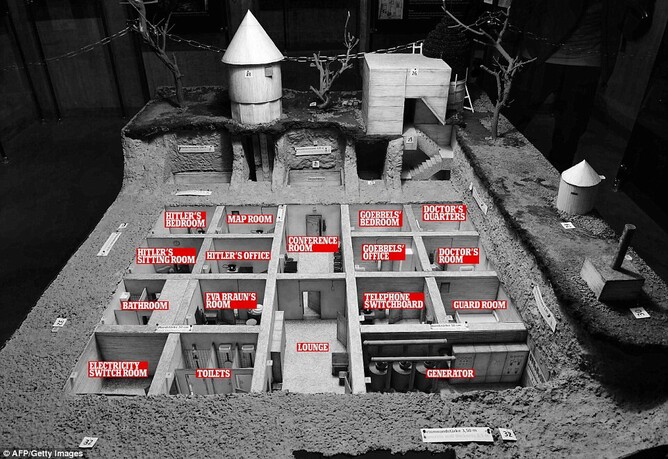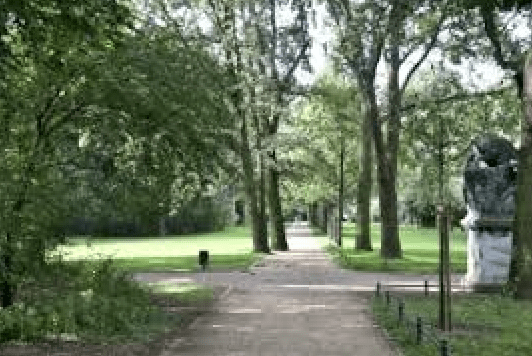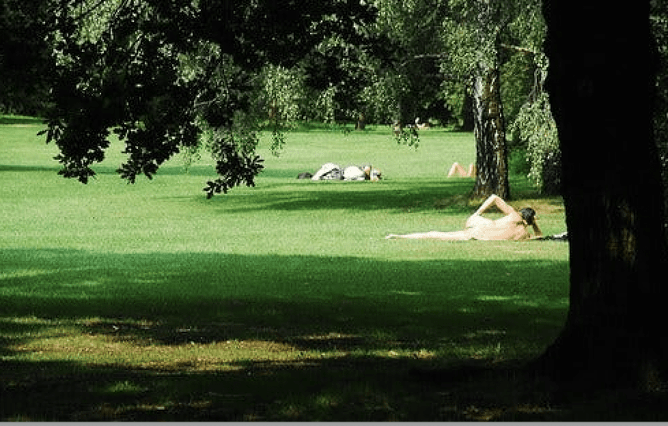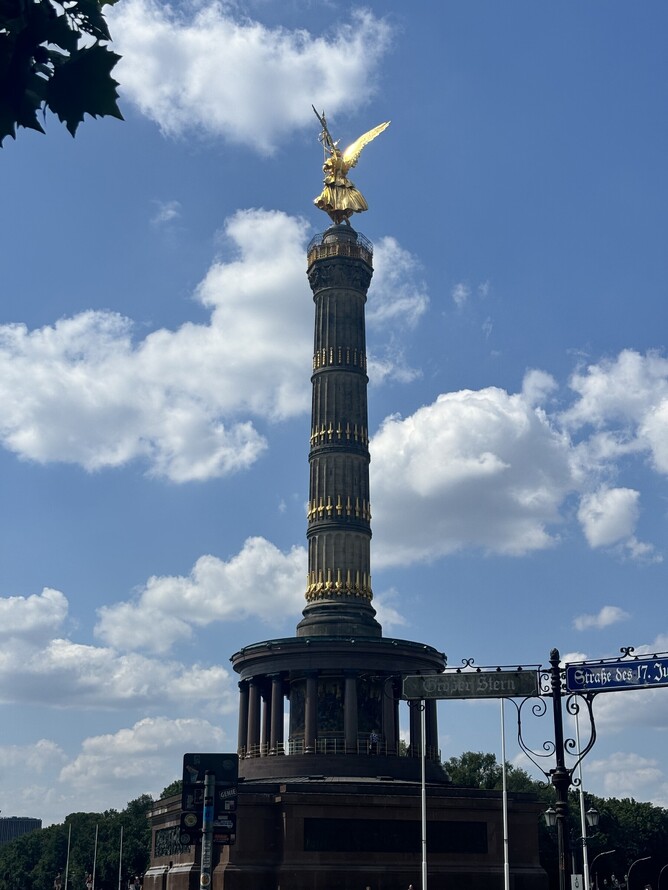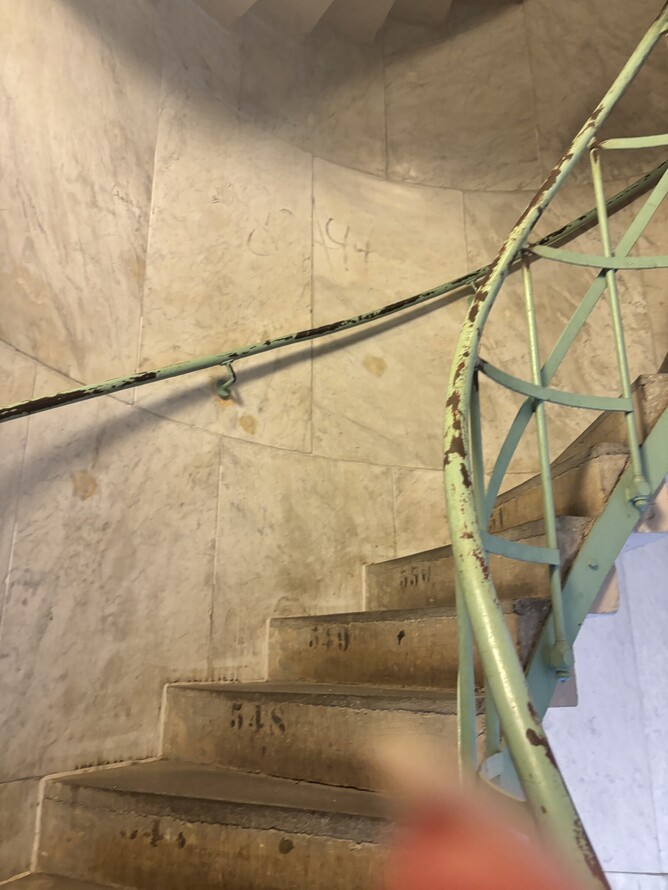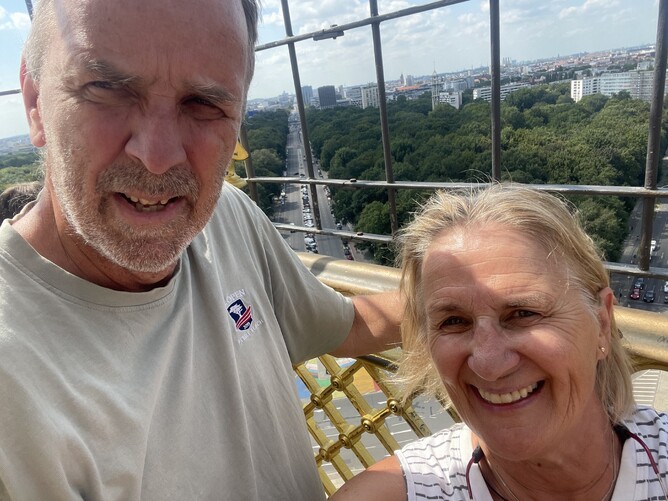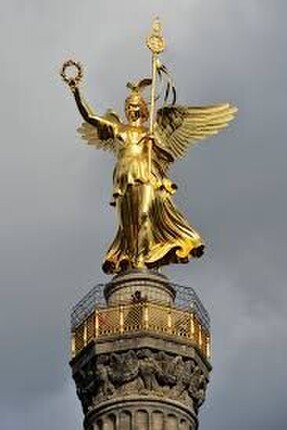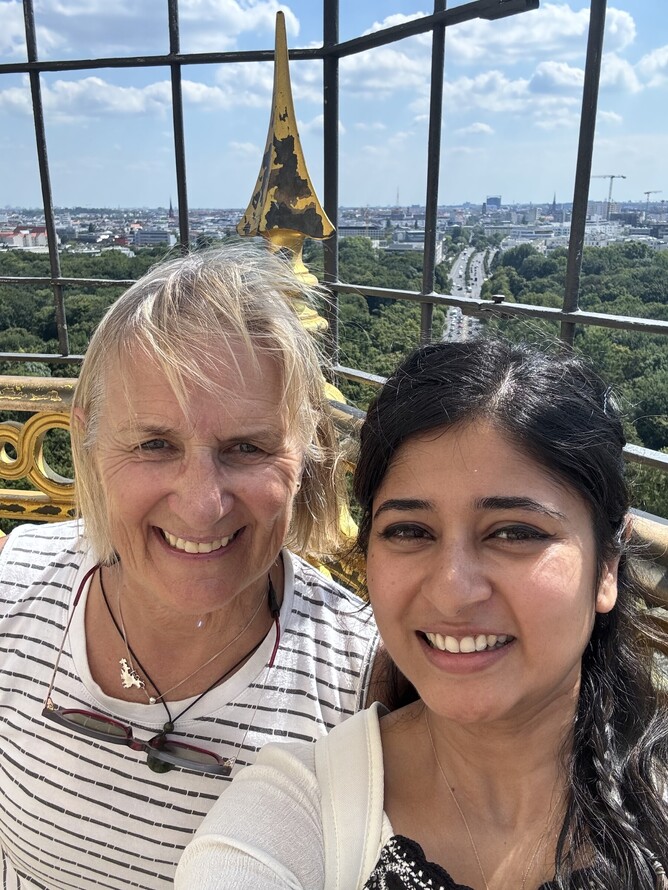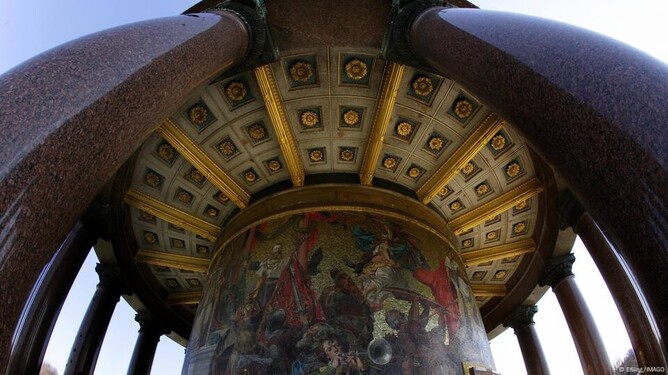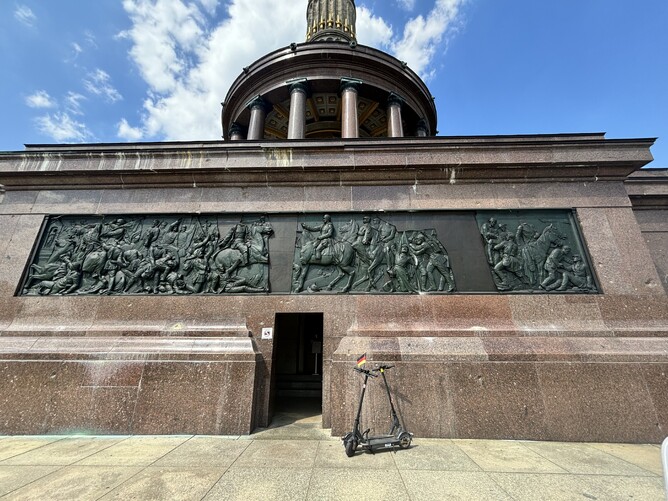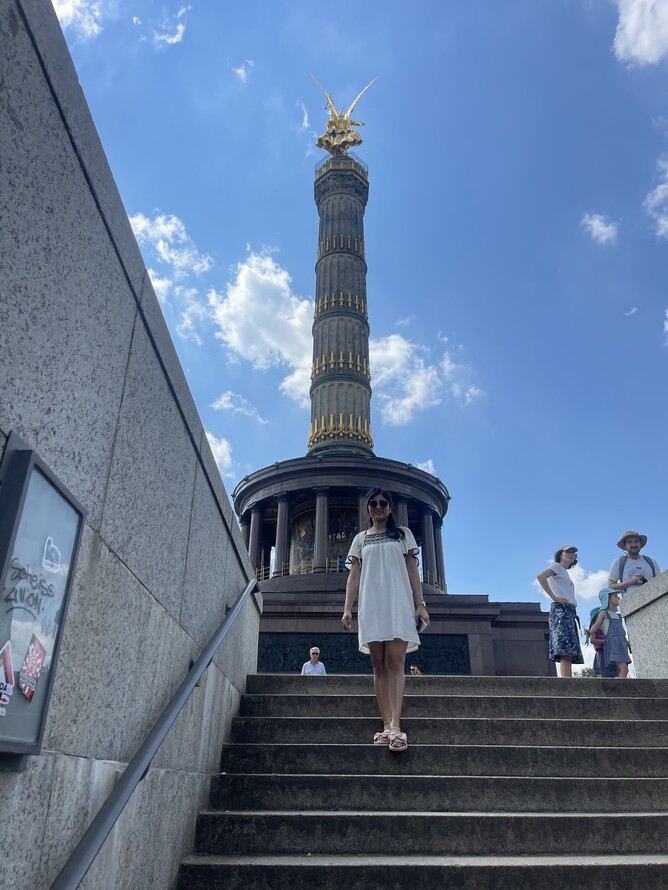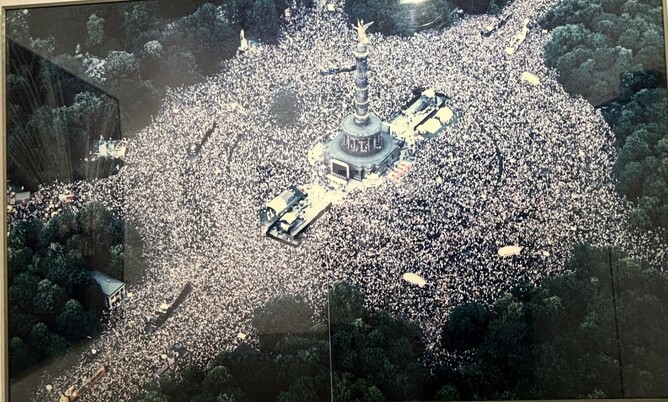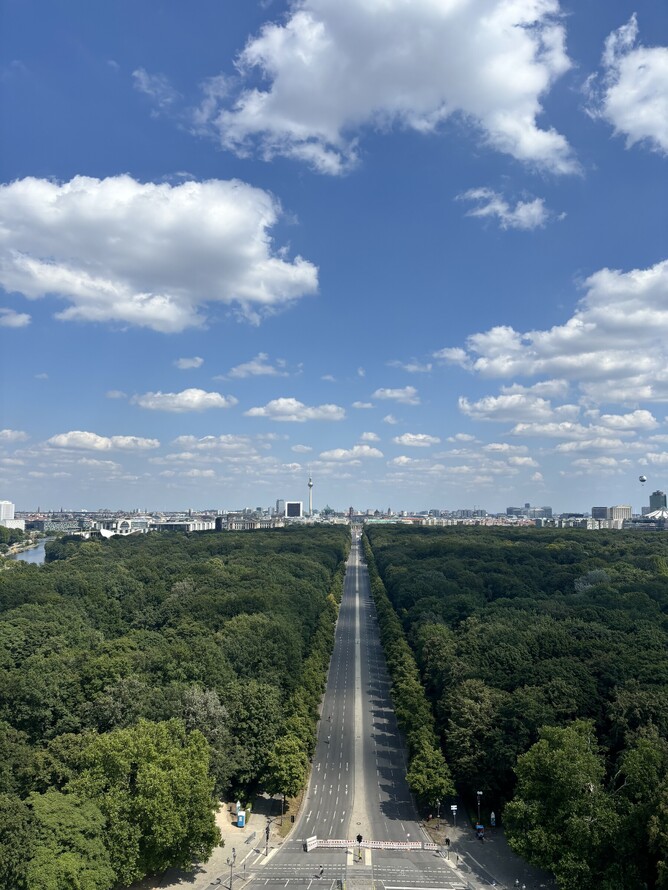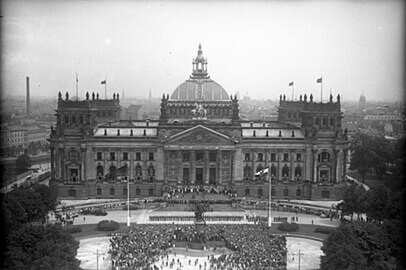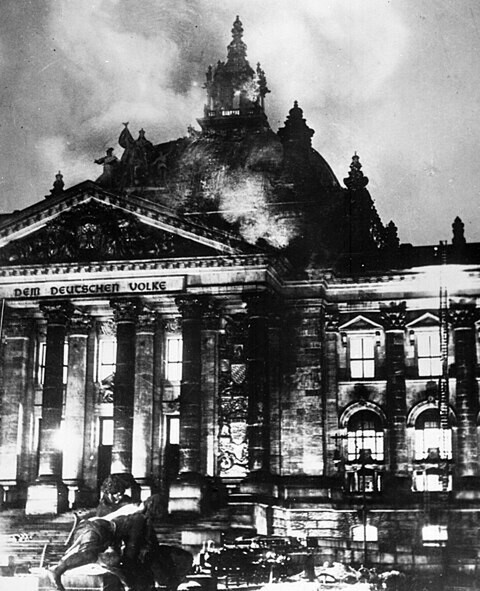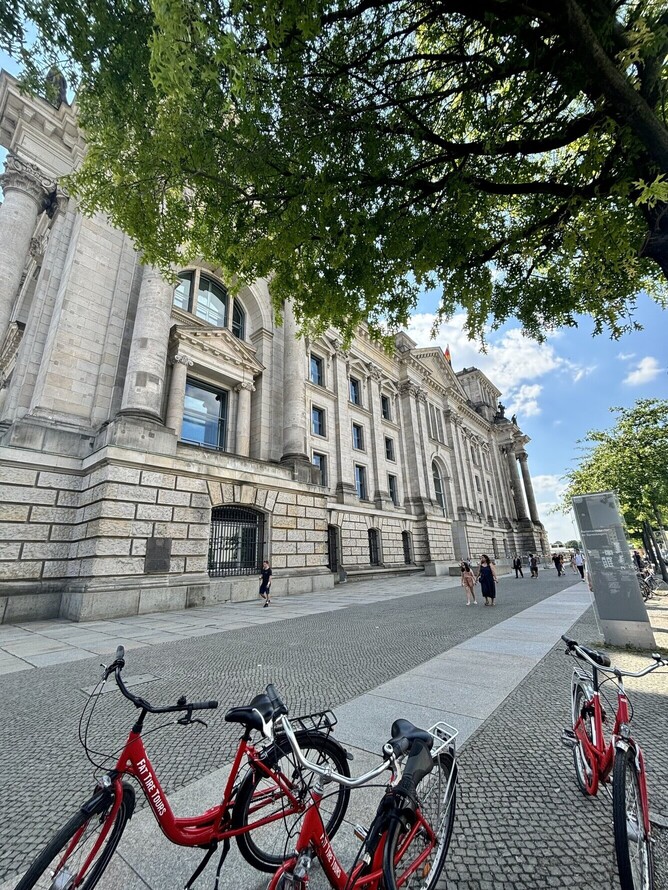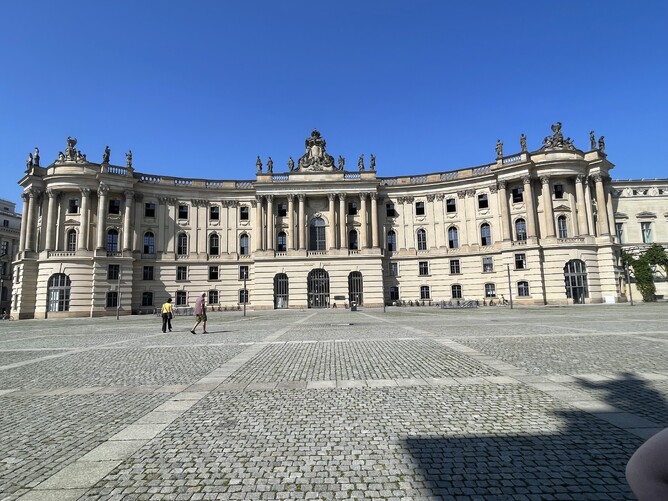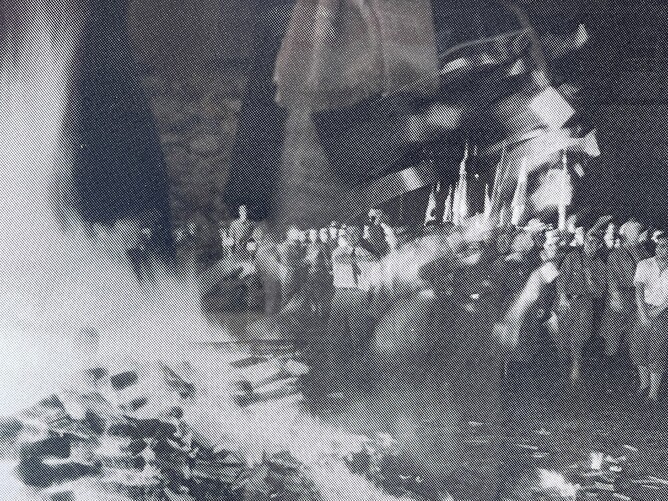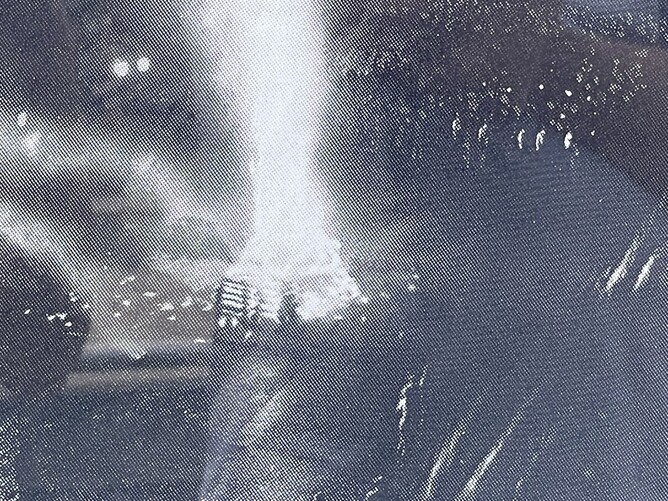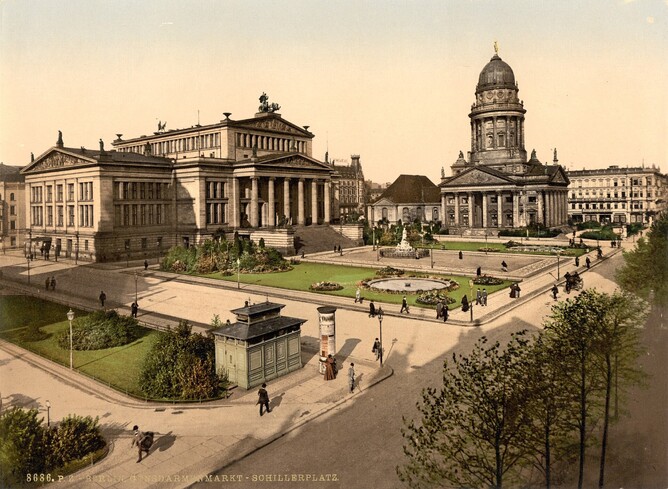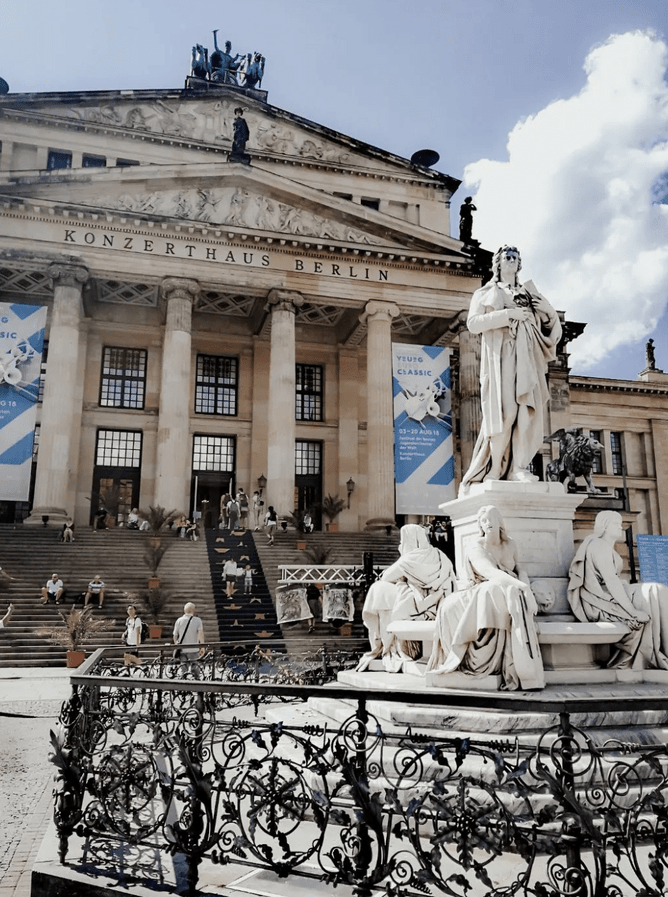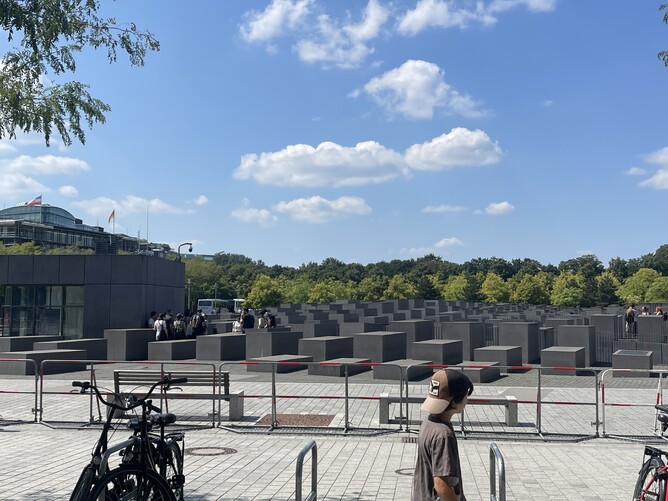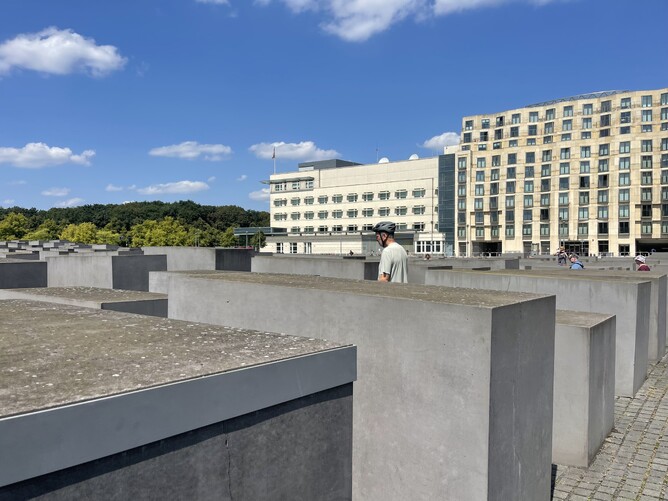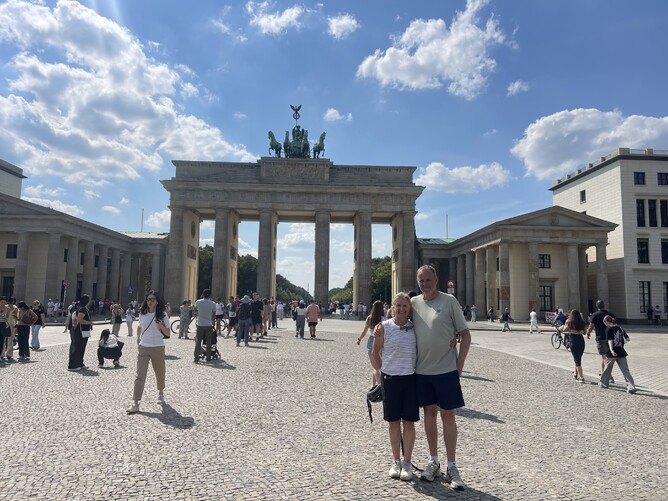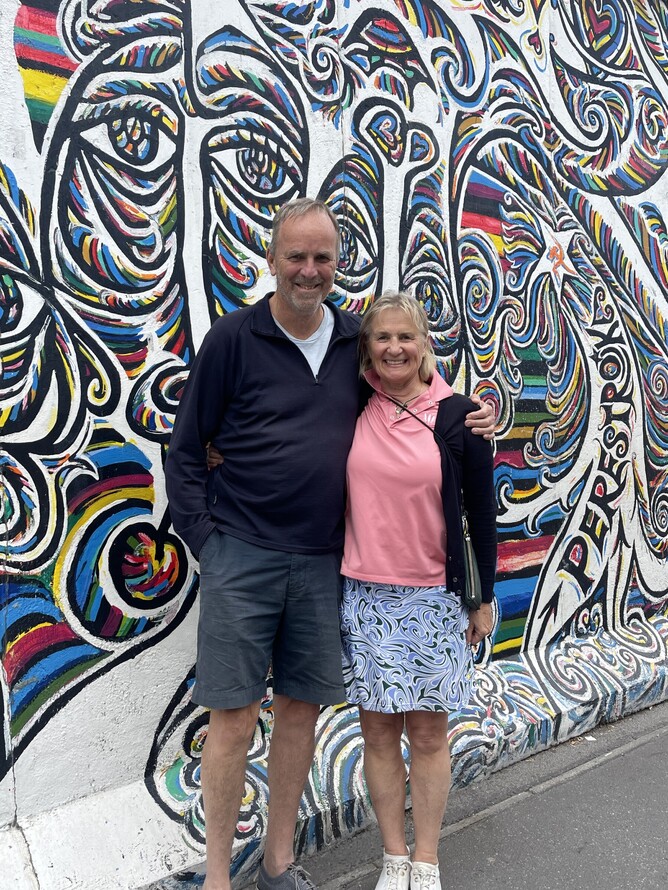We generally try to when we visit a city for the first time, go on a city bike tour. It is the first thing we do and so we did in Berlin. This tour is 6 hours, Nick is our guide. He is English and loves Berlin. I did history at school and learnt a drop in the ocean. After this tour I learnt a few more drops.
We met at the Fat Tires tour office, at Alexanderplatz, just under the TV Tower.
Nick briefed us.
These were our stops: Checkpoint Charlie, Berlin Wall, Nazi’s Architecture, Hitler’s Bunker, Victory Column, Tiergarten, Reichstag, Bebelplatz, Gendarmenmakt and the Memorial to the murdered Jews in Europe.
The Berlin Wall was obviously an important part of the tour.
Built in one night, the Wall encircled the city of West Berlin for 96km, cutting off access between East and West for nearly three decades from 1961 to 1989. Constructed under the orders of the East German government, on August 13, 1961, the Wall instantly cut thousands of Berliners off from one another and became one of the defining symbols of the Cold War.
Checkpoint Charlie was one place we visited on the bike tour where we learnt about the wall.
From Wikipedia: "The former military checkpoint was controlled by the Americans. Only foreigners, employees of the Permanent Mission of the Federal Republic of Germany in the GDR, and GDR officials were allowed to cross the border here.
There was hardly any other place where the atmosphere of the Cold War was as frosty as at Checkpoint Charlie. The border crossing gained notoriety in October 1961 after the construction of the Berlin Wall: in the last days of October, American and Soviet tanks took up positions here after members of the US mission were asked to identify themselves at the GDR border post when passing through the Allied checkpoint. Soviet and Allied tanks faced each other with live ammunition and a third world war almost ensued. In the years that followed, the checkpoint was the scene of spectacular escapes which often ended in death."
There were some successful escapes across the wall, but it was dangerous. After a few years the East Germans created what became called the "death strip". The death strip was the belt of sand- or gravel-covered land between the two main barriers of the Berlin Wall. It was constantly under surveillance by guards in watchtowers, who could shoot anyone they saw trying to escape.
Nick told us about one escape, which was from the far corner of the top of the building below, across the wall, that you can see on the left.
From ?:
"Who Dares Wins – From The Former Nazi Airforce Ministry
Date: 28th July 1965
Location: Niederkirchnerstraße, Mitte
To take on the Berlin Wall at the absolute heart of East Germany’s power structure took next level bravery. Enter Heinz Holzapfel, an engineer and economist, who had been called to the GDR’s House of Ministries (where East German premier Willi Stoph had offices) for a meeting. Disillusioned with socialism, Holzapfel bought along his wife and young son and holed his family up in a toilet cubicle, hanging an ‘out of order’ sign on the door. Late in the evening the Holzapfels emerged and made for the roof. Heinz hurled a hammer, painted with phosphorus and attached to a length of thin rope, across the Wall, which ran parallel to the southern edge of the building. Escape helpers in the west attached metal cable to the hammer and then the Holzapfels pulled it back up onto the roof. Using a homemade harness made of a bicycle wheel axle, Heinz first sent his son and then his wife gliding over the border via zip line, following after them himself. In a stunning turn of events, Soviet officers had witnessed the entire escape but presumed the STASI was smuggling agents into the west and didn’t open fire. When you devise an escape that daring, you deserve a healthy slice of luck."
This is a look from the other side. This is taken from a museum called Topography of Terror is. It is on the site of the Gestapo headquarters during the war. More on that later.
And here are some other escapes if you are interested as I was:
https://berlinexperiences.com/berlin-wall-eight-strangest-escapes/
A sample of the wall. You can see its thickness. 300 guard /tower stations were positioned along the 96km wall.
Nick explains that as communists took over East Berlin, residents started to leave . "Around 2.7 million people left the GDR and East Berlin between 1949 and 1961 (ie. before the Wall was built), causing increasing difficulties for the leadership of the East German communist party, the SED. Around half of this steady stream of refugees were young people under the age of 25.
After increasing tensions between the Soviets and the Western powers during the first 15 years of the Cold War, the Soviet Union decided to build a physical barrier between East and West Berlin. The German Democratic Republic began construction of the Berlin Wall in August 1961. On August 12, 1961 Walter Ulbricht, the first Secretary of the Socialist Unity Party and acting East German head of state, signed an order closing the border and erecting a wall.
In the early morning hours of 13 August 1961, temporary barriers were put up at the border separating the Soviet sector from West Berlin, and the asphalt and cobblestones on the connecting roads were ripped up. Police and transport police units, along with members of “workers’ militias,” stood guard and turned away all traffic at the sector boundaries. The SED leadership’s choice of a Sunday during the summer holiday season for its operation was probably no coincidence.
Over the next few days and weeks, the coils of barbed wire strung along the border to West Berlin were replaced by a wall of concrete slabs and hollow blocks. This was built by East Berlin construction workers under the close scrutiny of GDR border guards. Houses on, for instance, Bernauer Strasse, where the sidewalks belonged to the Wedding borough (West Berlin) and the southern row of houses to Mitte (East Berlin), were quickly integrated into the border fortifications: the GDR government had the front entrances and ground floor windows bricked up. Residents could get to their apartments only via the courtyard, which was in East Berlin. Many people were evicted from their homes already in 1961 – not only in Bernauer Strasse, but also in other border areas.
From one day to the next, the Wall separated streets, squares, and neighborhoods from each other and severed public transportation links. On the evening of August 13, Governing Mayor Willy Brandt said in a speech to the House of Representatives: “The Berlin Senate publicly condemns the illegal and inhuman measures being taken by those who are dividing Germany, oppressing East Berlin, and threatening West Berlin….”
In the years to come, the barriers were modified, reinforced, and further expanded, and the system of controls at the border was perfected. The border fortifications separating West Berlin from the rest of the GDR were 111.9 kilometers long. Well over 100,000 citizens of the GDR tried to escape across the inner-German border or the Berlin Wall between 1961 and 1988. More than 600 of them were shot and killed by GDR border guards or died in other ways during their escape attempt. At least 140 people died at the Berlin Wall alone between 1961 and 1989."
What is heart-breaking is the broken family stories overnight and then the separation for 28 years! Nick explains for some people, before 1961 they worked in the west and lived in the east. Some family members lived in the west too. Then for 28 years those families were forced to live separately. There was obviously no internet or mobile phones to communicate with each other. Some built platforms where they could communicate over the wall, showing new family. It was only a very small consolation. Families were broken up, oppressed and sad.
The wall came down on 9 November 1989, five days after half a million people gathered in East Berlin in a mass protest. East German leaders had tried to calm mounting protests by loosening the borders, making travel easier for East Germans
"World events often move fast, but it is hard to match the pace and power of change in 1989.
It culminated in one of the most famous scenes in recent history - the fall of the Berlin Wall.
The wall came down partly because of a bureaucratic accident . . . Notes about the new rules were handed to a spokesman, Günter Schabowski - who had no time to read them before his regular press conference. When he read the note aloud for the first time, reporters were stunned.
"Private travel outside the country can now be applied for without prerequisites," he said. Surprised journalists clamoured for more details. Shuffling through his notes, Mr Schabowski said that as far as he was aware, it was effective immediately." https://www.bbc.com/news/world-europe-50013048
Nazi architecture: "A high point of Nazi strategy was the staging of the 1936 Summer Olympics. Hitler positioned Berlin as the centre of an emerging nation and used the sporting event as a huge propaganda opportunity for Nazi Germany. Against this backdrop, the Olympic Stadium was built according to the plans of Werner March, whose assignment to the project predated the Nazi regime but whose designs nonetheless pleased Hitler.
The stadium was newly built, with the Reichssportfeld (a 132-hectare athletic complex) and the Maifeld (a huge lawn for gymnastic displays) also part of an architectural concept designed to radiate power."
Hitlers Bunker is now a parking lot - on purpose. The Germans didn't want it to become like a shrine.
From https://www.atlasobscura.com/places/fuhrerbunker-parking-lot . "On January 16th, 1945 Adolf Hitler went underground. Until his eventual death about five months later, he would live in a bunker below the garden of the Reich Chancellery, a site that is now a (purposefully) unremarkable parking lot.
Originally intended as an air-raid shelter, the Führerbunker underground complex was expanded to provide permanent protection for Hitler and other members of the Nazi leadership (Joseph Goebbels and his family would move into the bunker in April of 1945). The finalized Führerbunker was a multistory structure nearly 30 feet below ground and protected by 13 feet of concrete."
Below, the parking lot.
From https://pubmed.ncbi.nlm.nih.gov/15825245/: "For the last nine years of his life Adolf Hitler, a lifelong hypochondriac, had as his physician Dr Theodor Morell. Hitler's mood swings, Parkinson's disease, gastro-intestinal symptoms, skin problems and steady decline until his suicide in 1945 are documented by reliable observers and historians, and in Morell's diaries. The bizarre and unorthodox medications given to Hitler, often for undisclosed reasons, include topical cocaine, injected amphetamines, glucose, testosterone, estradiol, and corticosteroids. In addition, he was given a preparation made from a gun cleaner, a compound of strychnine and atropine, an extract of seminal vesicles, and numerous vitamins and 'tonics'.
It seems possible that some of Hitler's behaviour, illnesses and suffering can be attributed to his medical care. Whether he blindly accepted such unorthodox medications or demanded them is unclear."
Interesting fact: My father and Hitler shared the same birthday (not the same year they were born). My father definitely ruled the roost growing up.
We had lunch in the Tiergarten. Nice lunch and good chats.
From Wikipedia: "The beginnings of the Tiergarten can be traced back to 1527. It was founded as a hunting area for the Elector of Brandenburg, and was situated to the west of the Cölln city wall, which was the sister town of Old Berlin. In 1530 the expansion began; acres of land were purchased and the garden began to expand towards the north and west. The total area extended beyond the current Tiergarten, and the forests were perfect for hunting deer and other wild animals."
Tiergarten might literally be translated as animal garden.
We also spotted some nudists. It's quite a thing in Germany apparently.
Then to the Victory Column.
"The Victory Column was designed by Johann Heinrich Strack. Construction began in 1865 and took eight years. The winged sculpture of Goddess Victoria on top was designed by Friedrich Drake. The monument is meant to commemorate Germany's victories against Denmark, Austria and France between 1864 and 1871, a fact that is indicated by the sculpture's victorious pose as well as the gilded gun barrels on the columns and the mosaic by Anton von Werner in the colonnade."
We climbed to the top. 285 steps.
The goddess of Victoria (from Roman times) on the top.
You always meet people on these trips. Anusha is getting married in 20 days in India (1000 coming to the wedding). She lives in Munich with her future husband. They are here in Berlin because of her partner's work.
A mosaic mural showing off past war victories.
The bronze mural. This was taken away by the French during the wars and then put back. You can see some parts missing that they removed.
This was a photo of a massive celebration at the Victory Column, but I can't remember what it was.
We rode from the Victory Column up this street to the Brandenburg Gate. (A little on that later.) They had cleared the road for an upcoming triathlon that weekend, which was nice for us.
The Reichstag: "The building was initially used by the Reichstag (a historic legislative government) for Nazi Germany, but severe damage in the Reichstag fire of 1933 prevented further use and the Reichstag moved to the nearby Kroll Opera House. The 1933 fire became a pivotal event in the entrenchment of the Nazi regime. The building took further damage during the World War II, and its symbolism made it an important target for the Red Army during the Battle of Berlin.
After the war, the building was modernised and restored in the 1960s and used for exhibitions and special events, as its location in West Berlin prevented its use as a parliament building by either of the two Germanies. From 1995 to 1999, the Reichstag was fundamentally redesigned by Norman Foster for its permanent use as a parliament building in the now reunified Germany. The keys were ceremonially handed over to the President of the Bundestag, Wolfgang Thierse, on 19 April 1999. A landmark of the city is the redesigned walk-in glass dome above the plenary chamber, proposed by artist and architect Gottfried Böhm."
Bebelplatz: From Wikipedia: "The Bebelplatz (formerly and colloquially the Opernplatz) is a public square in the central Mitte district of Berlin, the capital of Germany. The square, then called Platz am Opernhaus (i.e. square at the opera house), was laid out between 1741 and 1743 under the rule of King Frederick II of Prussia. Frederick "the Great".
His Berlin palace is there and this is where his wife spent most of her time - but not him. He saw her once a year. Hence no kids Nick tells us.
The building below was the library.
"Nazi book burning: The Bebelplatz is known as the site of one of the infamous Nazi book burning ceremonies held in the evening of 10 May 1933 in many German university cities. The book burnings were initiated and hosted by the nationalist German Student Association . . . Besides other spectators, it was attended by members of the Nazi Students' League, the SA ("brownshirts"), SSand Hitler Youth groups. They burned around 20,000 books, including works by Heinrich Mann, Erich Maria Remarque, Heinrich Heine, Karl Marx, Albert Einstein and many other authors."
The Empty Library (you can see this briefly in the cobblestones in the video) is a Memorial in memory of the burning of books by Micha Ullman, consisting of a glass plate set into the cobblestones, and gives a view of a group of empty bookcases large enough to hold all 20,000 burned books. Its purpose is to commemorate the book burning.
Furthermore, a line of Heinrich Heine from his play, Almansor (1821), is engraved on a plaque inset in the square: "Das war ein Vorspiel nur, dort wo man Bücher verbrennt, verbrennt man am Ende auch Menschen." (in English: "That was only a prelude; where they burn books, they will in the end also burn people").
Students at Humboldt University hold a book sale in the square every year to mark the anniversary."
Gendarmenmakt. From https://www.gendarmenmarkt.de/EN/history-gendarmenmarkt-berlin-mitte-english.htm
"It is said to be the most beautiful square in Berlin, maybe even in Europe: the Gendarmenmarkt. It is located in Berlin’s historic centre, covers 3.3 hectares and is one of the German capital’s top hot spots.
It has long been at the top of any tourist’s sightseeing list; more than a million visitors come to the Gendarmenmarkt each year, as well as quite a few business people and Berliners themselves.
The square offers by far and away the best and most exclusive locations and events in the whole of the city; there are numerous restaurants and cafés where you can sit and relax, luxury shops and boutiques are scattered throughout the square as well as along the nearby shopping mile, Friedrichstraβe. Lovers of culture flock to the fantastic performances at the concert hall and for international business people, the square is the hub and focus of Berlin, with its famous hotels, banks, offices, clinics and estate agents."
Now it is under construction to upgrade it.
Memorial to the murdered Jews in Europe. From Wikipedia: "
Memorial to the Murdered Jews of Europe, also known as the Holocaust Memorial is a memorial in Berlin to the Jewish victims of the Holocaust, designed by architect Peter Eisenman and Buro Happold. It consists of a 1.9-hectare (4.7-acre) site covered with 2,711 concrete slabs or "stelae", arranged in a grid pattern on a sloping field. They are organized in rows, 54 of them going north–south. An attached underground "Place of Information" holds the names of approximately 3 million Jewish Holocaust victims, obtained from the Israeli museum Yad Vashem."
This might not be them all. It would take 6 years to read them all out.
We were asked to go right into the middle of the artist's work. We came back and shared what we felt and/or experienced. I felt each stone represented a family/house, the loss of so many families and the impact that had on others left, the coldness of the grey, the undulating land represented for me the twists and turns, and unexpected these peoples lives went through before they died and for those they left behind. 250,ooo Jews died. The population of Hamilton NZ is 220,000. A whole city wiped out.
Brandenburg Gate, Berlin's Symbol of Unity.
"The Brandenburg Gate acquired special symbolic power during the time when Berlin was divided. With the construction of the Berlin Wall in August 1961, the monument led a lonely existence because it was henceforth in the restricted area and could be visited neither by East Berliners nor by people from the West. With the fall of the Wall in 1989, the Brandenburg Gate became a symbol of reunification. On December 22, 1989, the gate was opened to the cheers of more than 100,000 people. However, the Quadriga was so badly damaged by the reunification celebrations that it had to be restored two years later."
Around the Brandenburg Gate: Pariser Platz
The Brandenburg Gate is located in the center of Berlin on Pariser Platz ("Parisian Square"), one of the most beautiful squares in the city. The magnificent boulevard Unter den Linden leads directly to the square, which is lined with numerous noteworthy buildings such as the luxury hotel Adlon Kempinski, the University of the Arts, and the US Embassy. The surrounding cafés and restaurants invite visitors to stay a while and take in the special atmosphere.
The unity of Berlin and the world is a great note to end on. The emerging artwork.
Here the human spirit has been crushed in the past but now there is a freedom that has emerged. People are very friendly and open. Germany does a good job of showing there is a way to acknowledge history, and acknowledge the horrors, and acknowledge the miracles (the escapes), and show the world they can move on.
Berlin's creativity in their cafes and the way they show history is inspiring.
When we went to the Topography of Terrors, it was hard to believe one man changed the world so much, and so many people were killed. I loved the people who escaped and the way people hid and helped one another. Few and far between in comparison to all the bloody stuff that went on. Maybe they carved the way for us all who are still here. This is hopeful for me. I am going to acknowledge the miracle that life is and every moment.
